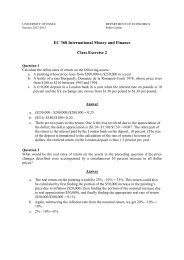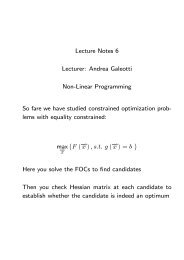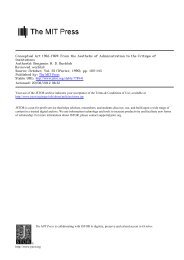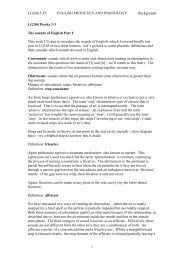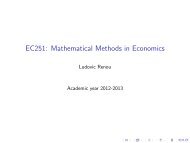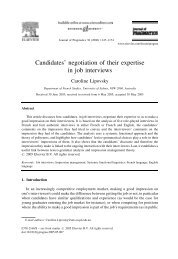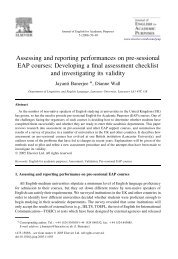3D graphics eBook - Course Materials Repository
3D graphics eBook - Course Materials Repository
3D graphics eBook - Course Materials Repository
You also want an ePaper? Increase the reach of your titles
YUMPU automatically turns print PDFs into web optimized ePapers that Google loves.
Shadow mapping 183<br />
External links<br />
• Hardware Shadow Mapping (http:/ / developer. nvidia. com/ attach/ 8456), nVidia<br />
• Shadow Mapping with Today's OpenGL Hardware (http:/ / developer. nvidia. com/ attach/ 6769), nVidia<br />
• Riemer's step-by-step tutorial implementing Shadow Mapping with HLSL and DirectX (http:/ / www. riemers.<br />
net/ Tutorials/ DirectX/ Csharp3/ index. php)<br />
• NVIDIA Real-time Shadow Algorithms and Techniques (http:/ / developer. nvidia. com/ object/ doc_shadows.<br />
html)<br />
• Shadow Mapping implementation using Java and OpenGL (http:/ / www. embege. com/ shadowmapping)<br />
Shadow volume<br />
Shadow volume is a technique used in <strong>3D</strong> computer <strong>graphics</strong> to add<br />
shadows to a rendered scene. They were first proposed by Frank Crow<br />
in 1977 [1] as the geometry describing the <strong>3D</strong> shape of the region<br />
occluded from a light source. A shadow volume divides the virtual<br />
world in two: areas that are in shadow and areas that are not.<br />
The stencil buffer implementation of shadow volumes is generally<br />
considered among the most practical general purpose real-time<br />
shadowing techniques for use on modern <strong>3D</strong> <strong>graphics</strong> hardware. It has<br />
been popularised by the video game Doom 3, and a particular variation<br />
of the technique used in this game has become known as Carmack's<br />
Reverse (see depth fail below).<br />
Example of Carmack's stencil shadowing in<br />
Doom 3.<br />
Shadow volumes have become a popular tool for real-time shadowing, alongside the more venerable shadow<br />
mapping. The main advantage of shadow volumes is that they are accurate to the pixel (though many<br />
implementations have a minor self-shadowing problem along the silhouette edge, see construction below), whereas<br />
the accuracy of a shadow map depends on the texture memory allotted to it as well as the angle at which the shadows<br />
are cast (at some angles, the accuracy of a shadow map unavoidably suffers). However, the shadow volume<br />
technique requires the creation of shadow geometry, which can be CPU intensive (depending on the<br />
implementation). The advantage of shadow mapping is that it is often faster, because shadow volume polygons are<br />
often very large in terms of screen space and require a lot of fill time (especially for convex objects), whereas<br />
shadow maps do not have this limitation.<br />
Construction<br />
In order to construct a shadow volume, project a ray from the light source through each vertex in the shadow casting<br />
object to some point (generally at infinity). These projections will together form a volume; any point inside that<br />
volume is in shadow, everything outside is lit by the light.<br />
For a polygonal model, the volume is usually formed by classifying each face in the model as either facing toward<br />
the light source or facing away from the light source. The set of all edges that connect a toward-face to an away-face<br />
form the silhouette with respect to the light source. The edges forming the silhouette are extruded away from the<br />
light to construct the faces of the shadow volume. This volume must extend over the range of the entire visible<br />
scene; often the dimensions of the shadow volume are extended to infinity to accomplish this (see optimization<br />
below.) To form a closed volume, the front and back end of this extrusion must be covered. These coverings are<br />
called "caps". Depending on the method used for the shadow volume, the front end may be covered by the object<br />
itself, and the rear end may sometimes be omitted (see depth pass below).





